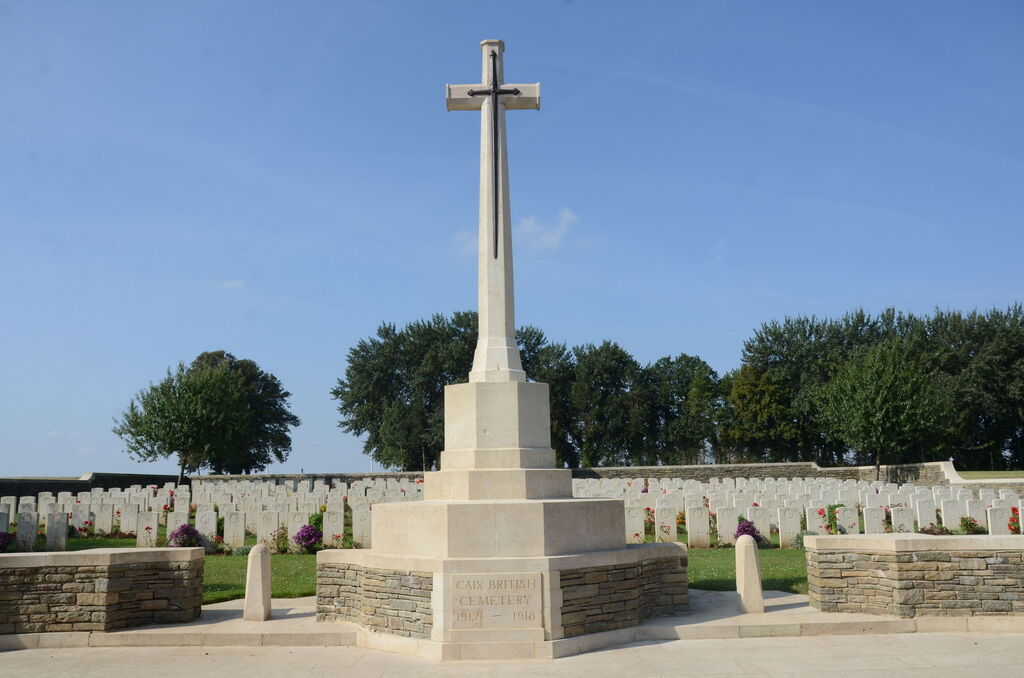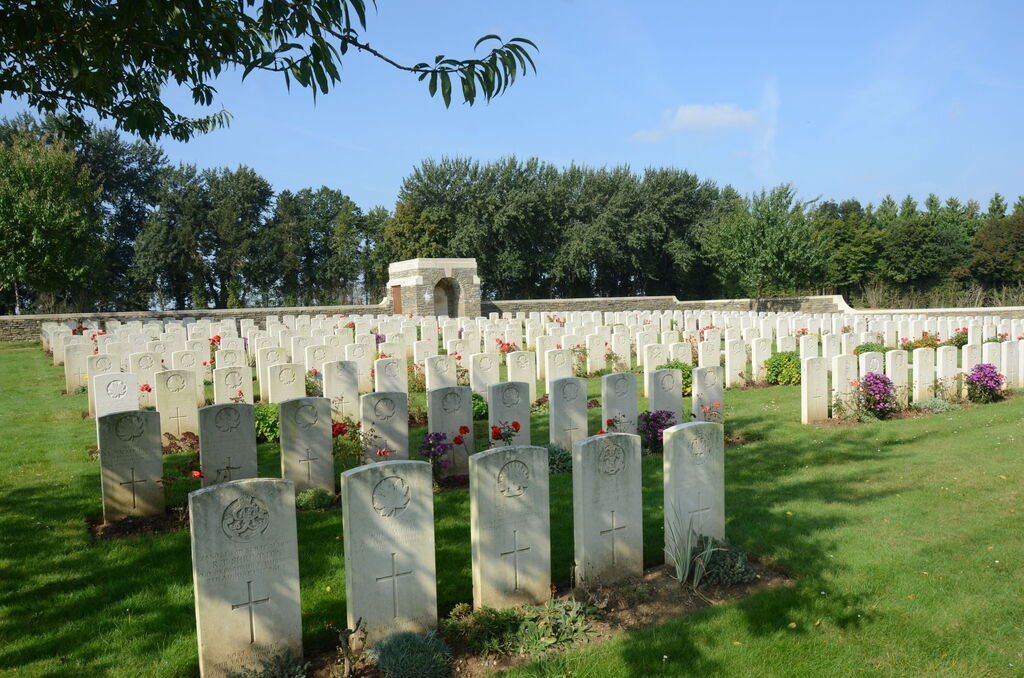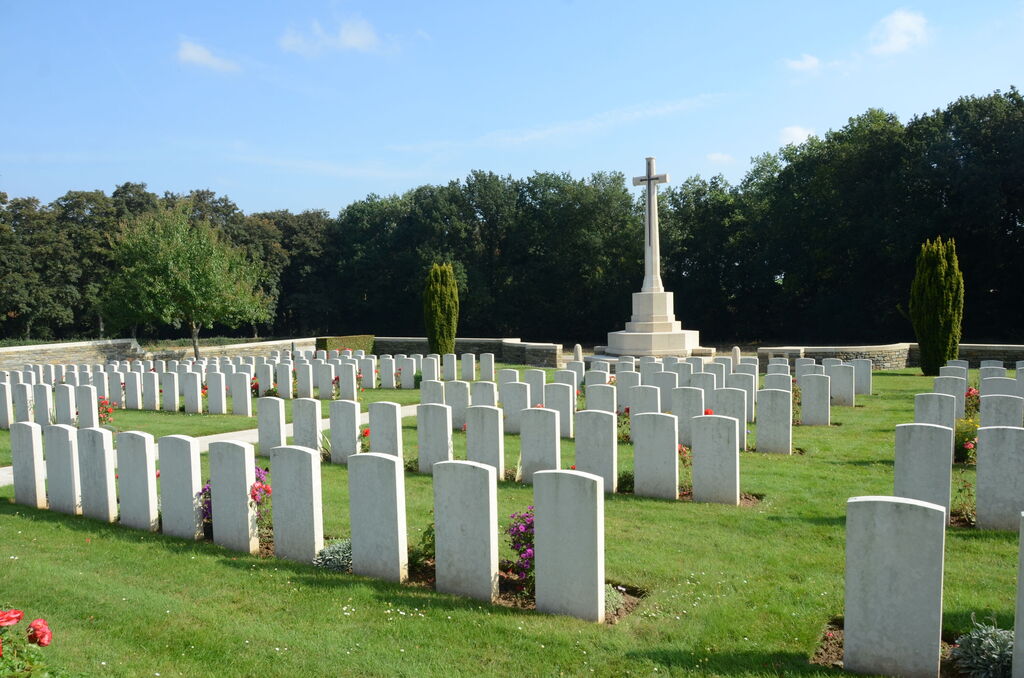Caix British Cemetery
- Country France
- Total identified casualties 302 Find these casualties
- Region Somme
- Identified casualties from First World War
- GPS Coordinates Latitude: 49.81098, Longitude: 2.65072
Location information
The village of Caix is situated about 28 kilometres south-east of Amiens, midway between the N29, Amiens to St. Quentin road, and the D934, Amiens to Roye road. The Cemetery is south of the village.
From the centre of the village on the main road, D28, in the direction of Beaucourt en Santerre, turn left at the D41 in the direction of Le Quesnel. About 200 metres along this road is the local communal cemetery and the first CWGC signpost will be found. Turn left just before the local cemetery and follow the side road where the British Cemetery will be found on the right.
Visiting information
ARRIVAL
The cemetery is signposted with a green CWGC Cemetery Direction sign at the junction of the D41. A single lane road leads south past the Caix Communal cemetery towards the Caix German Cemetery. The cemetery is approximately 250 metres south of the junction.
PARKING
It is possible to park alongside the single lane track in front of the cemetery main entrance on the grass verge.
The verge extends the length of the front of the cemetery, including in front of the unrestricted access entrance, to the left of the main entrance. The ground is flat and firm with a tarmac topped road and grass adjacent to the cemetery.
ACCESS LAYOUT AND MAIN ENTRANCE
The main entrance is in the centre of the perimeter wall within 2 metres of the parking area.
There is grass between the road and the semi-circular paving in front of the entrance.
The Cross of Sacrifice is built into the main entrance in the middle of a paved semi-circular area. There are 1-metre wide openings on either side of the Cross with stone bollards in the middle of the openings, leaving a 50 centimetre opening on either side of the bollards.
A 15-centimetre stone step leads up to the openings. Paving carries through the behind the Cross of Sacrifice and up to the shelter building at the rear of the cemetery. The paving inside the cemetery is level with the grass.
The Register Box is inside the cemetery, built into the low-level wall adjacent to the entrance to the right of the Cross viewed from inside the cemetery.
At the rear centre of the cemetery is a shelter with internal stone bench seating. There is a step up of approximately 150 mm to the interior seat inside the shelter.
All internal paths are grass; the ground is firm and mostly flat with a slight incline towards the rear of cemetery and the shelter.
ALTERNATIVE ACCESS
There is an accessible entrance with a gap in the cemetery boundary wall (1.90 metres) to the left of the main entrance into the cemetery.
The entrance is signposted.
The ground is flat and firm with paving between the wall opening, level with the grass outside and inside the cemetery. There is a black metal chain that can be released on the right side of the opening with a latch built into the chain.
ADDITIONAL INFORMATION
The cemetery is permanently open.
History information
Caix was occupied by Commonwealth troops in March 1917, lost during the German advance in March 1918, and recaptured on 8 August 1918 by the Canadian Corps.
Caix British Cemetery (called at first Caix New British Cemetery) was made after the Armistice when graves (mainly of March and August 1918) were brought in from the battlefields and from the following smaller cemeteries:-
BEAUCOURT CHATEAU GERMAN CEMETERY, in the Chateau grounds at Beaucourt-en-Santerre, which contained the graves of three soldiers and one airman from the United Kingdom who fell in March and April, 1918.
BEAUFORT GERMAN CEMETERY, in an orchard near Beaufort Church, from which the graves of three soldiers from the United Kingdom, who fell in April, 1918, were removed (one other was reburied in Hangard Communal Cemetery Extension).
CAIX (Old) BRITISH CEMETERY, close to a farmhouse on the East side of the village. It was made by the Canadian Corps, and it contained the graves of 91 soldiers from Canada and 19 soldiers and airmen from the United Kingdom who fell in August, 1918.
CAYEUX CHATEAU GERMAN CEMETERY, at Cayeux-en-Santerre, containing the graves of 13 soldiers and one airman from the United Kingdom and one Canadian soldier. One soldier and one airman were buried by the enemy, twelve cavalrymen and one Canadian by the 3rd Cavalry Division in August, 1918.
DE LUCE BRITISH CEMETERY, CAIX, close to the North Bank of the river, which contained the graves of 17 soldiers and airmen from the United Kingdom, eight Canadian and five Australian soldiers, all of whom fell in August, 191 8.
LE QUESNEL GERMAN CEMETERY (a little East of Le Quesnel Church), in which four men of the Canadian Mounted Rifles were buried by their comrades in August, 1918.
RIDGE CEMETERY, HANGARD, West of Hangard village, looking down on the Luce, contained 20 Canadian soldiers who fell on the 8th August, 1918.
The cemetery now contains 373 Commonwealth burials of the First World War, 73 of them unidentified.
The cemetery was designed by Sir Herbert Baker.




